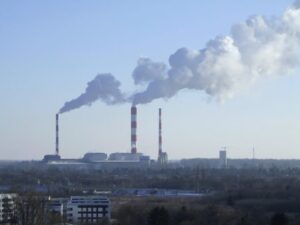It is a very interesting period for the European electricity system, which is undergoing big, systematic changes. The transition towards a low-carbon economy means a growing role for renewable energy sources, greater energy efficiency and the electrification of transport and other sectors, which power markets have to respond to. Naturally, in such a framework, electricity is expected to play a key role – writes Magdalena Kuffel, BiznesAlert.pl author.
This shift is going to bring numerous consequences to the companies within power sector. On one side, it is expected that the demand for electricity is going to rise in the following years (with the expected rapid growth coming from the transportation sector); on the other side, the source of produced electricity is going to be more important than ever before. It is evident that secure, stable power supply will become an issue of the highest importance, which could be challenging with the current state of RES penetration and the forecast that this tendency will grow. Renewables in the energy mix mean less pollution, but unfortunately also lower level of programmability.
There is another aspect which RES have an influence on. Over the last decade, we have experienced the “clean energy” pushing electricity price down, causing a lot of conventional power generators to not be able to keep up with market competition; the ones with higher fixed costs, had been forced to either phase out (old blocks) or move into mothballing (the newer plants). Diminishing capacity of conventional generation, which is stable, programmable and relatively cheap, threatens stability of the system. To address that, European Commission introduced a tool known to everyone within power sector – “capacity mechanism”.
Capacity mechanism/ CM (having a form of a payment or dedicated secondary product market) has a goal of ensuring active (operational) generation capacity in the EU. Initially, the mechanism had intended to “create a price signal” and attract investments in the new, flexible thermal power plants. After a few successful implantations of the capacity mechanism/market in UK or France, the results of tenders clearly showed that prior assumption did not face reality. As have been seen in the British example, payments did not stimulate new investments, but “keep alive” plants that otherwise would have been closed. The last auction (which results have been published in February 2017) has been “dominated” by gas-fired stations that are one of the cleanest fossil fuels plants (40 % of the contracts) and coal and biomass (25 %). It means that, at least until 2021, the coal power plants (which in theory should be in the process of phasing out).
European Commission has shared the fear of a comparable situation with the Polish government, once the Polish Capacity Market would be in place. Even though the project is technologically neutral, Commission fears that Polish CM would end up turning into subsidy system for new coal power plants (which is not in line with the European strategy of decarbonising its economy). ICIS, market intelligence provider, confirms EC’s doubts and points out numerous indications to believe that the implementation of capacity market in Poland would only further embed the country’s reliance on coal-fired generation, that already accounts for over 90% of national generation.
The same problem could be faced in other countries which historically base its power production of coal, such as Germany, Bulgaria, Romania, Czech Republic or Hungary. Just passed April, the Commission answered negatively to the German proposal for the capacity market (who, as a matter of fact, has pretty similar energy sector structure as Poland), with the justification that at this stage it is believed that Germany may not have carried out all possible market reforms that would enable the market to fully ensure security of supply at lowest possible cost and without the need for state intervention (=capacity market). Even if capacity measures are well designed, they cannot replace essential electricity market reforms.
To exclude the oldest coal generation capacity, European Commission suggested (as part of Winter Package) to regulate Capacity Market a bit further than technical requirements of participating units. In order to ensure that “unwanted” blocks don’t participate in the mechanism, EC suggests application of 550 g CO2/kWh pollution limit, which can be emitted in the production process (in short called 550 EPS – Emission Performance Standard). Such threshold would apply to already existing plants 5 years after entry into force of the Regulation (giving units enough time for eventual modernizations) and shall be applied immediately to the newly constructed unit. It is said that eventual application of 550 EPS would impact 24 % of baseload thermal capacity in Western Europe (ranging from 0 % in France to 72 % in Germany) and 41 % of baseload capacity in Eastern Europe (91 % in Poland and 100% in Bulgaria!). Consequently, old blocks would be pushed out of the market and new, modern, typically peak power plants would take over responsibility of baseload generation.
The scheme looks good on paper, but could bring numerous problems, which EU is not necessarily prepared for. The main implication would be an increase in gas consumption throughout Europe. According to study ran by Compass Lexecon, implementation of 550 EPS within capacity markets would mean an increase in gas consumption of 100TWh per year in Western Europe (until 2035) and by 90 TWh – 160 TWh in Eastern Europe (by 2040). The study predicts that half of the increase in gas consumption would come from Poland, putting significant constraints on its gas and supply network.
Such “massive” shift in the production mix, in relatively short period of time, would require rapid and economically significant investments in gas infrastructure. Furthermore, it would surely raise a question on countries’ energy independence (especially in those countries which do not have LNG terminals), which would not only depend on the fuel supply from the third parties, but also due to the fact that the power production would be – again – dependant predominantly on one source of power (less polluting than coal, but still singular source).
Figure: Additional gas consumption in Western and Eastern Europe, in case of implementing 550 EPS within capacity markets (2020-2040)

Source: Eurelectric, Compass Lexecon
There is another problem which 550 EPS can contribute to. The current European system, as a whole, limits the emission level already pretty significantly and introduction of further limits can cause just one possible scenario: construction of new power plants network from scratch. One cannot forget about Best Available Techniques (BAT) Reference Document for the Large Combustion Plants (which are a subject to ongoing discussions) or practically non-functioning ETS (Emission Trading Scheme). Even though European Union Emissions Trading System (EU ETS) is the cornerstone of the European Union’s policy tackling climate change, it has not proved to be an appropriate tool for cost-effective reduction of emissions of carbon dioxide and other greenhouse gases. The revised regulatory proposal (with timeline set up to 2030) suggests the 43% greenhouse gas reduction target in 2030 in the ETS into a cap declining by 2.2% annually from 2021 onwards, corresponding to an additional reduction of around 556 million tonnes of carbon dioxide in the period 2021-2030 compared to the current annual decline of 1.74%. More ambitious climate goals can surely contribute to the success of the scheme, but due to the nature of traded commodity, it can end up being a big fail again. Carbon, unlike corn or oil, is not a tangible product. Carbon permits are a “permission to pollute in the future”, which tends to be estimated by proxy rather than actually measured. In such a framework, there is still a bit room for manipulation, which can cause another big time fail of ETS.
Last but not least, it is worth remembering that the costs associated with the capacity market, which would be transferred on the customers (whether in the form of a new levy incorporated into electricity bill or higher price of electricity as such). With 550 EPS, customer cost would increase by €108 billion over the period 2020-2040 (on the top of already predicted capacity market cost) throughout EU (Compass Lexecon). It would not be that shocking if there would be a proof that the system brought expected results, but market modelling doubts whether 550 EPS would achieve policy objectives of decarbonisation, with the current ETS cap in place (it would only add extra cost on the top of ETS price). Stricter emission limits would “lock out” approx 9 GW of generation, which could not be replaced with innovative solutions like batteries/Storage or Demand Response systems (due to the costs and still underdeveloped technology).
The conclusion of the analysis is truly difficult and brings a lot of question marks to the picture. The first question would be – and had been already asked numerous times on the international arena – whether or not Capacity Market is needed; there are numerous voices stating that well designed and appropriately controlled electricity market would financially stimulate the development of generation mix by itself. The second question coming up would be eventual cost of the implementation of Capacity Market and whether the overall cost of the investments would be in line with the real “danger” that lack of capacity brings. Considering the fact that majority of units participating in the market already exist (some have to go under modernization, some not), it shows a clear message that there is enough capacity in the market; therefore, it not only confirms the fact that there is enough generating units (which would be in operation, if the price of electricity was higher) on the market, but also that new investments would only create overcapacity. Last but not least, it is hard to pass over the impression that EC wants to “fight” market manipulation (fear of subsidizing polluting assets) with the same method; 550 EPS would favour one power source over the other.
The European Commission shall soon expressed its opinion over the Polish model of capacity market and frankly speaking, one can expect anything. The proposal of Polish government suggested sound support to the system, which has been dealing with lack of capacity, especially in the period of extreme weather conditions. One can be hopeful that position of Poland is fully understood and that any changes would be discussed with the country’s representatives, in order to plan better solution for the economy at the current state. Poland has expressed numerous times its interest in moving Polish economy towards more sustainable model, but it would need to happen gradually and not at the cost which would negatively impacts it customers (including last September’s statement of the Minister of Energy, not planning any new coal investments).








